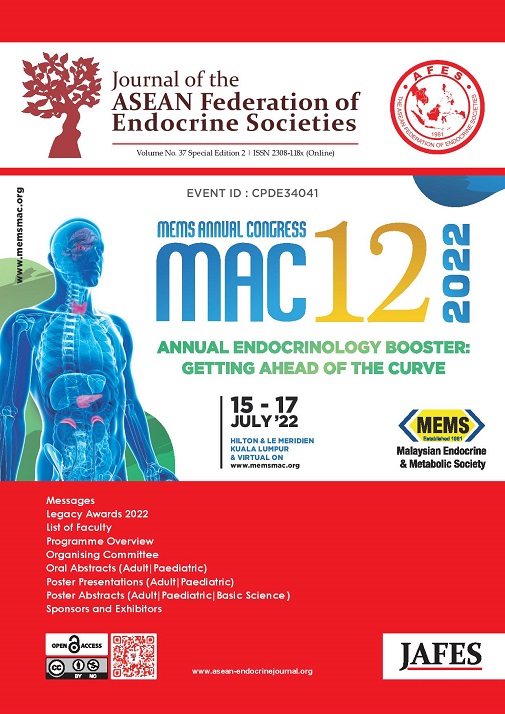PREVALENCE OF LOW BONE MINERAL DENSITY AND ITS ASSOCIATED RISK FACTORS IN PATIENTS WITH DIFFERENTIATED THYROID CANCER RECEIVING TSH SUPPRESSION THERAPY
Keywords:
low bone mineral density, thyroid cancer, TSH suppression therapyAbstract
INTRODUCTION
TSH suppression therapy has been reported to cause low bone mineral density (BMD). Osteoporotic fracture is associated with increased morbidity and mortality. Hence, a targeted screening for osteoporosis is important. The aim of this study is to determine the prevalence of low BMD among patients with differentiated thyroid cancer (DTC) receiving TSH suppression therapy and its associated risk factors.
METHODOLOGY
This was a cross–sectional study done at Hospital Putrajaya. About 98 patients with DTC receiving TSH suppression therapy (mean TSH levels ≤0.5 mIU/L within the past one year) were recruited between August 2020 and March 2021.
RESULTS
The prevalence of low BMD among patients with DTC on TSH suppression therapy was 27.6% (osteopenia=22.4%, osteoporosis=4.1%, BMD below the expected range for age=1%). Age was a risk factor for low BMD with the adjusted odds ratio (AOR) of 1.14, 95% confidence interval (CI)=1.032–1.262, p=0.010. In addition, postmenopausal women had a 9–fold higher risk of low BMD compared to men (AOR=8.64, 95% CI=1.436–51.921, p=0.019). Patients with mean TSH <0.1 mIU/L had a 6–fold increased risk of low BMD compared to those with mean TSH between 0.1 mIU/L to 0.49 mIU/L (AOR=6.33, 95% CI=1.111–36.072, p=0.038). Lastly, patients who were on calcium supplementation had an 88% lower risk of low BMD compared to those who were not on calcium (AOR=0.12, 95% CI=0.025–0.556, p=0.007).
CONCLUSION
Our study suggests that over a quarter of the patients with DTC receiving TSH suppression therapy have low BMD, mostly among the older population, postmenopausal women, and patients with mean TSH levels <0.1 mIU/L. We should also consider calcium supplementation to prevent bone loss during TSH suppression therapy.
Downloads
References
*
Downloads
Published
How to Cite
Issue
Section
License
Copyright (c) 2022 Lee Siow Ping, Azraai Bahari Nasruddin

This work is licensed under a Creative Commons Attribution-NonCommercial 4.0 International License.
The full license is at this link: http://creativecommons.org/licenses/by-nc/3.0/legalcode).
To obtain permission to translate/reproduce or download articles or use images FOR COMMERCIAL REUSE/BUSINESS PURPOSES from the Journal of the ASEAN Federation of Endocrine Societies, kindly fill in the Permission Request for Use of Copyrighted Material and return as PDF file to jafes@asia.com or jafes.editor@gmail.com.
A written agreement shall be emailed to the requester should permission be granted.







